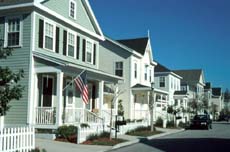index
New Urbanist look and feel
click on images for full-size:




Houses close together in Celebration, Florida

Apartments at King Farm, Maryland

Town houses in Middleton Hills, Wisconsin
Compared to familiar sprawling suburbs, New Urbanist developments are more concentrated, with smaller lot sizes and houses arranged on streets whose layout and dimensions are planned to encourage interaction and neighborliness. These features resemble traditional towns, though even here there may be more regularized sets of lot sizes. Also New Urbanist neighborhoods make provisions for automobiles that were not common in older towns, such as invisible parking lots on the interior of blocks behind stores.The ratio of homes to commercial establishments feels different than in traditional towns, because New Urbanist commercial establishments tend to be concentrated in neat town centers and elsewhere there are few or no productive workplaces except perhaps home-offices. This may change over time as the New Urbanist developments age. A traditional town tends to have workplace sites of small-scale production, and a few larger productive sites, scattered throughout rather than absent or banished to outlying areas.Within the housing types, for instance in Kentlands, King Farm, or Middleton Hills, there may be more apartments and more town houses than would have been expected in a traditional town. If the developments are able to achieve their ideal of mixed income housing, this too will be different from many old towns, especially in the spatial mixture of the incomes.